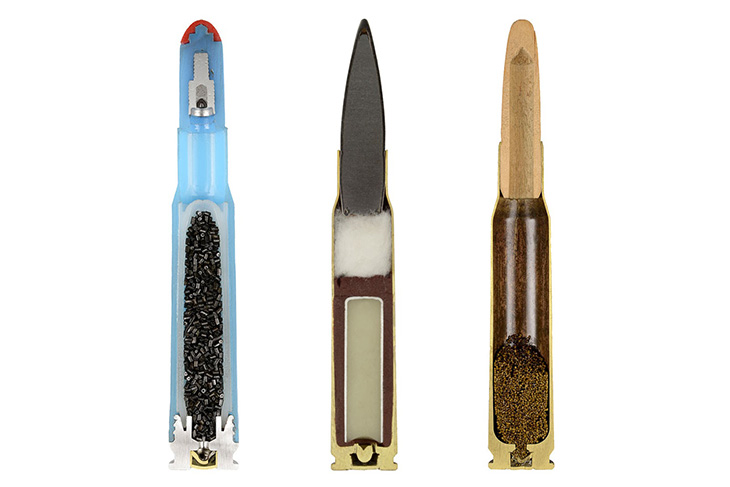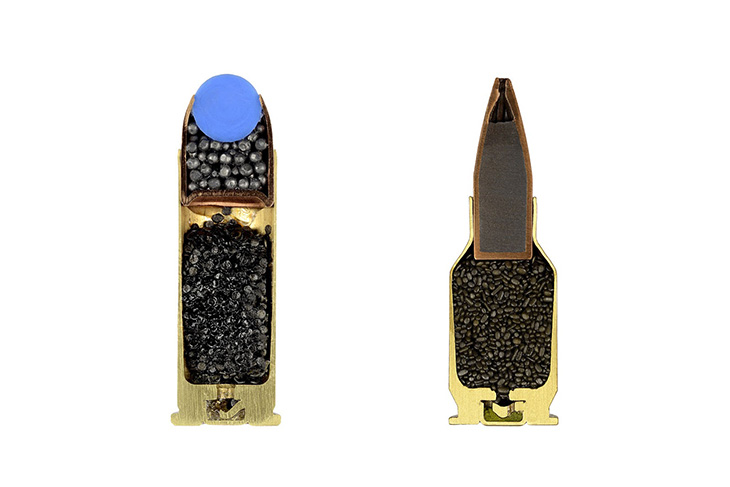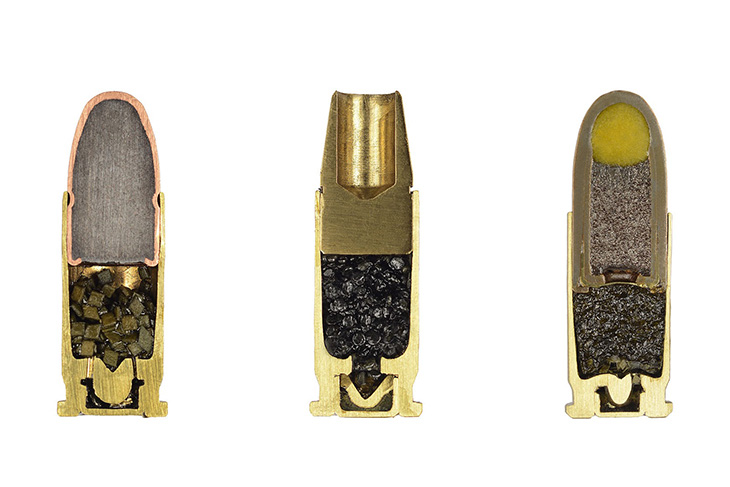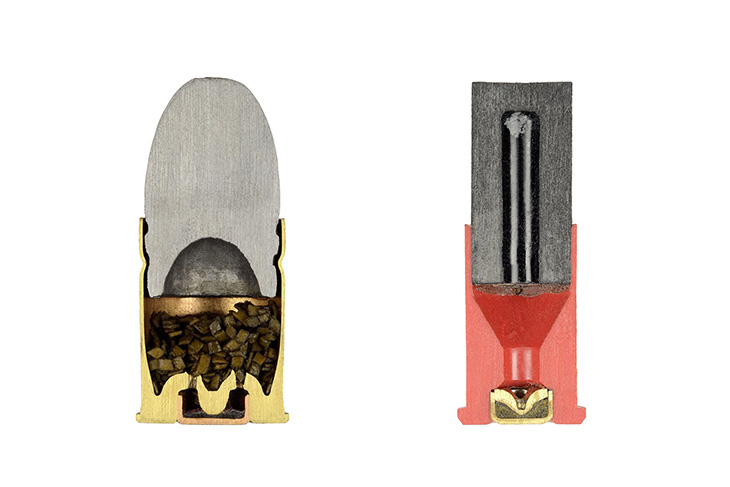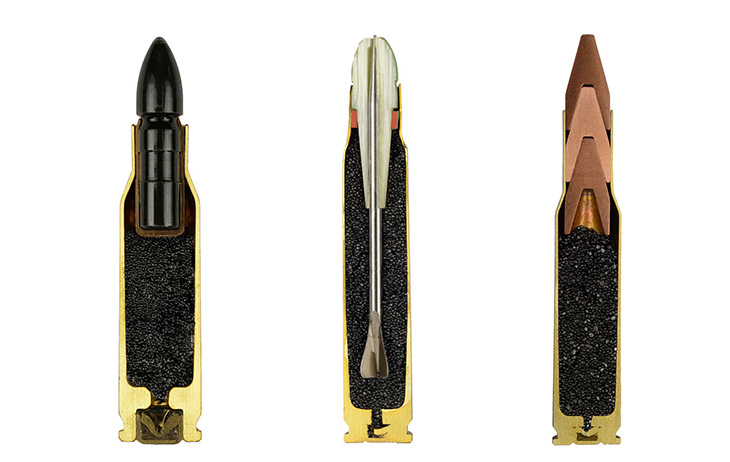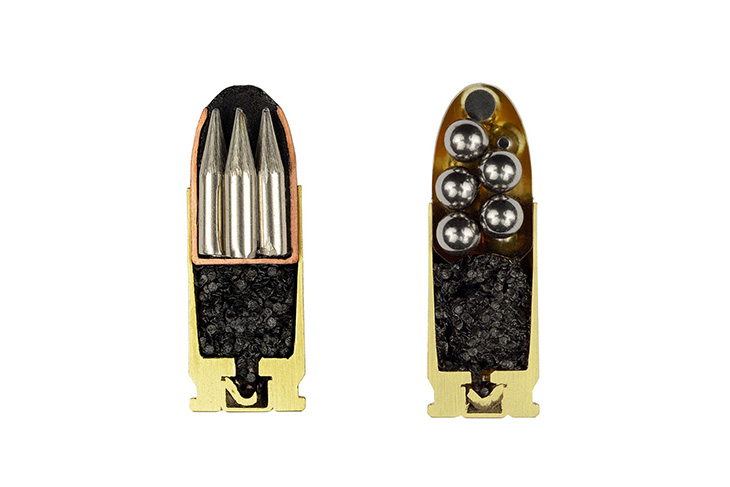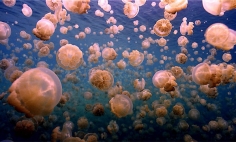Even if you’re not a fan of weapons and ammunition, this will keep you entertained. Using multiple ammunition cross-sections inside a WWII bunker in Switzerland, Sabine Pearlman photographed this amazing series that will definitely surprise you.
A few of these are strange very rare bullets which even many ballistics and gun experts were unable to identify. All in all I think she did an awesome job. Also always handy is to clean your guns before use.
In her own words-
This series of ammunition cross-sections was photographed inside a WWII bunker in Switzerland in October of 2012. The entire series consists of 900 specimen. I was originally intrigued by the ambiguous nature of the subject matter. The cross-sections reveal a hidden complexity and beauty of form, which stands in vast contrast to the destructive purpose of the object.
- (left) 7.62x51mm Plastic short-range training tracer, a type of ‘Simunition’ training ammo, designed for short-range training ranges where stray bullets and ricochets could be a concern (the whole blue section is the projectile). This one has a radiogenic tracer pellet that allows visual tracking of the round in daylight and night conditions.
- (center) 7.92mm Mauser – an early German bullet used during the wars of the first half of the 20th century, however, during WWII, it was one of the few cartridges used by both the Axis and Allies. This particular specimen seems to be a ‘sabotage’ exploding cartridge, as it appears to be loaded with a blasting cap and a small amount of explosive.
- (right) 6.5x55mm wood bullet, usually used for drill rounds or for blanks in automatic weapons. The reason they are used in automatic weapons is that the wood bullet generates enough pressure to operate the action, but is normally shredded by a muzzle attachment.
- (left) .38 Special Glaser Blue Safety Slug, a frangible bullet made by Cor-bon in 70’s and was the precursor to sintered or “safety” rounds that are supposed to basically disintegrate upon first impact. The original round was a hand-made hollow point bullet filled with No. 12 birdshot (0.05″) with a flat polymer cap (the blue circle).
- (right) .224 BOZ, developed in the late 1990s with the purpose of defeating body armour. Original trials were successful, with this round firing a 50 gr projectile chronographed at over 2,500 ft/s (760 m/s). The main application of this bullet was intended to be made available for anti-terrorist and special forces use, not civilian use.
- (left) Round-nosed Full Metal Jacket (FMJ), this bullet (often used for handguns) is of a soft lead core encased in a shell (jacket) of harder metal, usually cupronickel or gilding metal. The jacket allows for higher muzzle velocities than bare lead without depositing significant amounts of metal in the bore. The jacket allows for higher muzzle velocities than bare lead without depositing significant amounts of metal in the bore.
- (center) Solid brass Hyrda Shok FMJ hollow point, an expanding bullet that has a pit or hollowed out shape in its tip often intended to cause the bullet to expand upon entering a target in order to decrease penetration and disrupt more tissue as it travels through the target. It is also used for controlled penetration, where over-penetration could cause collateral damage (such as on an aircraft).
- (right) 9mm tracer round (or possibly an explosive projectile), these type of bullets are built with a small pyrotechnic charge in their base. Ignited by the burning powder, the pyrotechnic composition burns very brightly, making the projectile visible to the naked eye. This enables the shooter to follow the projectile trajectory to make aiming corrections.
- (left) .455 Webley, a British handgun cartridge, innovated in 1887, most commonly used in the Webley top break revolvers Marks I through VI. The .455 cartridge was a service revolver cartridge, featuring a rimmed cartridge firing a .45 bullet at the relatively low velocity of 650 ft/s (190 m/s). The result was a cartridge and handgun combination with relatively mild recoil, but with good penetration and excellent stopping power. It was rated superior to the .45 Colt.
- (right) .38 Speer Plastic Training bullets, designed in the 70s, this is a reusable molded plastic training component (red) with a firing primer (black) for short-range practice up to 25 feet. They are intended to operate with little recoil, giving the user better ability to practice aiming and technique.
- (left) HK DM11 Penetrator Ultimate Combat, a German cartridge, designed for the MP7 firearm, this bullet can penetrate the NATO CRISAT target at more than 300 meters. It is designed to minimize weight and recoil while increasing penetration of body armor. It features a bottle-necked case and a pointed, steel-core, brass-jacketed bullet.
- (center) 5.56mm XM216 Flechette, a bullet designed specifically for the Special Purpose Individual Weapon (SPIW) needlegun, which fires a small fin-stabilized metal dart. The purpose of this gun and ammo was to eventually replace the military’s M16 (an idea had around the 90s), since it was lighter weight and had less recoil (being that it just shot a litter arrow), however, this plan never manifested. Interestingly, the name of the bullet ‘Fletchette’ is actually French for ‘little arrow.
- (right) 7.62/.220 Salvo Squeezebore projectile, a triplex bullet which, when fired, are separated by compression into three separate projectiles in a circular dispersion, increasing hit probability. Projectiles were designed to be lethal to at least 400m and disperse in a pattern that would ensure at least one hit on a man-sized target at 400m.
- (left) 9x19mm Cobra “High Safety Ammunition” multi-dart – an experimental cartridge of steel darts inside a polymer sabot that was made in the early 1970’s and was supposedly meant as an armor-piercing round for use by troops that went into tunnels where a low muzzle-flash and low-recoil cartridge would be needed.
- (right) 9x19mm Israeli riot control shrapnel shell – an anti-personnel cartridge with steel balls embedded in amber resin, which would be ejected upon firing, allowing them to continue along the shell’s trajectory and strike the target individually, operating very much in the same way a land-mine would.
Image credit: Sabine Pearlman, H/T: Imgur.com
These bullets looks amazing. SHARE it with your friends and amaze them too.
